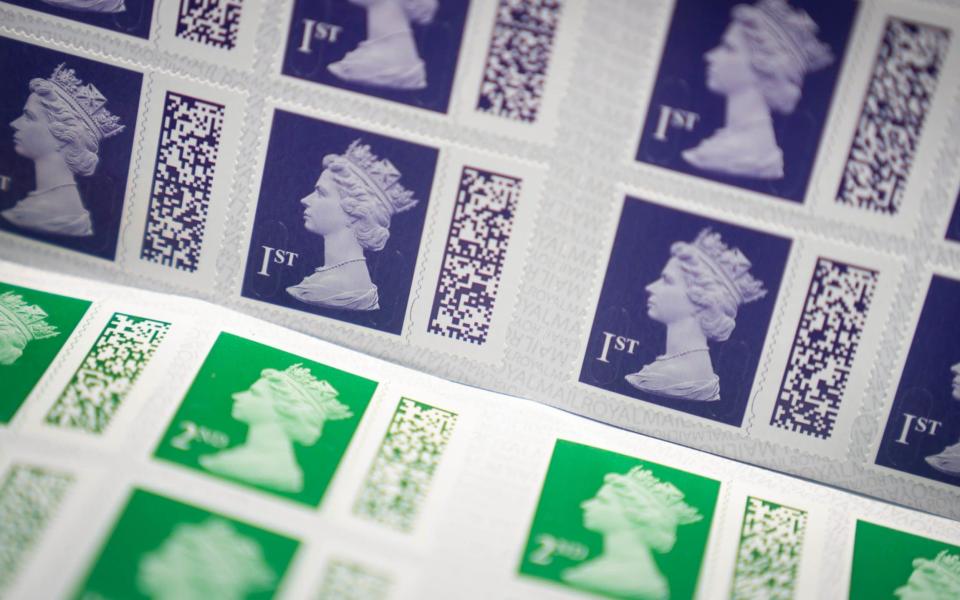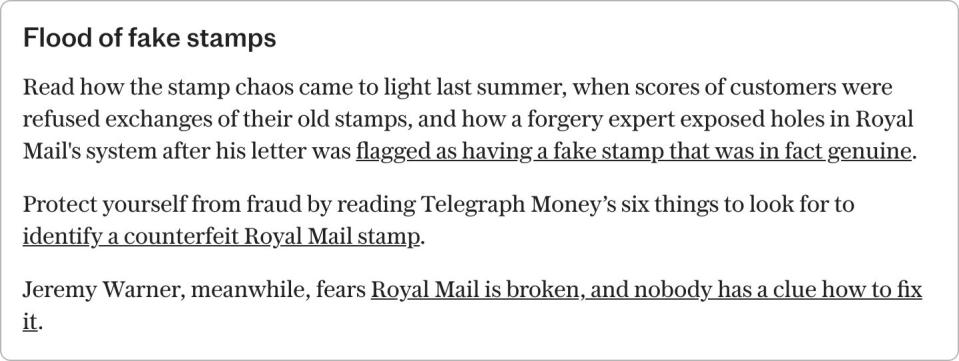Royal Mail fined 158,000 people for ‘fake’ stamps before finally pausing penalties

Royal Mail fined close to 160,000 customers for counterfeit stamps before the penalty was dropped over fears they were wrongly applied.
The postal service collected £686,000 in fines from 158,000 customers in a nine-month period between July 2023 and March this year but maintains it did not profit from the surcharges.
In that period, the fine doubled from £2.50 to £5 as Royal Mail introduced new barcode scanners to identify fake stamps in delivery offices nationwide.
Royal Mail suspended the controversial penalties last month after a Telegraph campaign revealed a number of fines may have been incorrectly issued.
Whistleblowers at the time said they feared mistakes were being made – with genuine stamps ruled fakes – and said staff were using Google to identify counterfeits due to a lack of training.
In March, The Telegraph also revealed that China was flooding Britain with counterfeit stamps in what security experts described as an “act of economic warfare”.
Royal Mail disclosed the total number of penalties issued after Labour MP Liam Byrne, who is chairman of the Business and Trade Committee, wrote to the firm’s new chief executive Emma Gilthorpe demanding answers in light of the public concern.
However in his response to the Committee, acting chief executive Martin Seidenberg defended the use of surcharges and said Royal Mail “was absolutely committed to ensuring that customers can buy and use stamps with confidence”.
“I know that customers need certainty that the stamps they purchase, and use, are genuine, and that concerns have been expressed about the surcharging of items posted using counterfeit stamps,” the letter said.
“Surcharging provides an important deterrent and is used by postal authorities in many countries. It is vital that Royal Mail and the UK are seen not to tolerate counterfeiters who mass produce, and illegally profit from, these illegitimate stamps.”
Mr Seidenberg added that Royal Mail continues to “work with law enforcement agencies to disrupt the manufacture and wholesale distribution of counterfeit stamps both in and outside the UK”.
However, none of the four major Chinese suppliers identified by The Telegraph at the beginning of April offering to print up to one million counterfeit stamps per week for as little as 4p have had their listings taken down, despite this newspaper sharing its findings with Border Force.
Mr Seidenberg wrote that while it had “good relationships” with Border Force, the National Crime Agency, Trading Standards agencies and local police forces, these groups had “many competing priorities”. He called on the Government to allocate more funding for clamping down on counterfeit stamps.
“We would, of course, welcome any additional resource that could be directed to help spot counterfeit stamps entering the UK, and to help us tackle the wholesale distribution of these stamps that only profit criminals,” he said.
The Telegraph first reported in August that it had seen 40 instances of customers claiming that stamps bought from Post Offices or the Royal Mail website had been flagged as counterfeit.
The price of a first class stamp in Britain has doubled since March 2019 when it was just 67p. Since then, there have been seven price rises, culminating in last month’s rise to £1.35 for a first class stamp and 85p for a second class stamp.
Royal Mail is currently developing a new scanner in its app which will allow customers to scan barcodes to verify a stamp’s authenticity.
The postal service will also use an independent stamp expert to verify whether a stamp is genuine after fears were raised in-house staff were making mistakes.
Insiders expect the app update could take until July. In the meantime, the postal service is using yellow stickers to warn recipients if a stamp is fake.
The yellow sticker reads: “This item has been identified as bearing a counterfeit stamp. You may wish to advise the sender. A surcharge has not been applied on this occasion.”
However, if a letter does include the return address, the letter will be returned and the sender charged £5 for using a counterfeit stamp.
A Royal Mail spokesman said: “The number of counterfeits we see in our network is reducing rather than growing. As a result of our interventions, we have achieved a significant reduction.
“Counterfeit stamps now account for a fraction of a per cent of the c.450 million stamped items in our network annually, having declined by c.90% since the introduction of barcoded stamps.
“This has been achieved through a series of interventions we have made. As well as the introduction of unique barcodes on Definitive stamps, these measures include added security features, increased activity to target the criminal supply of counterfeit stamps, and surcharging items that have been sent using counterfeit stamps.
“These actions have significantly disrupted the criminals’ activity. Although this is a huge step forward, we are not complacent and there is more to be done.”


 Yahoo Finance
Yahoo Finance 